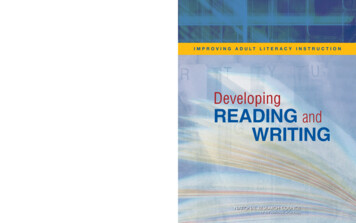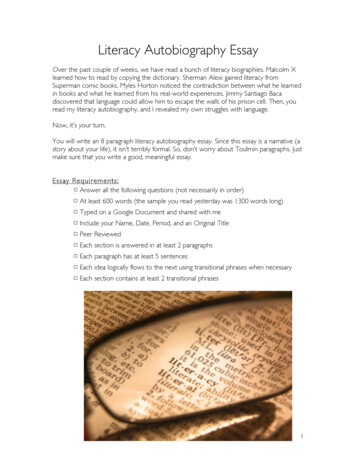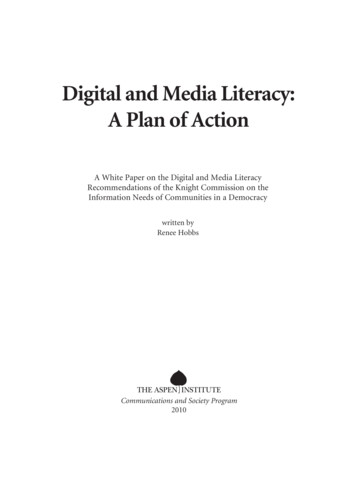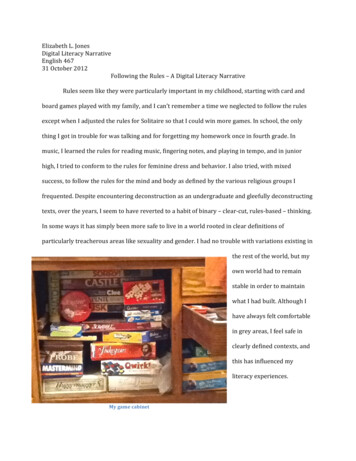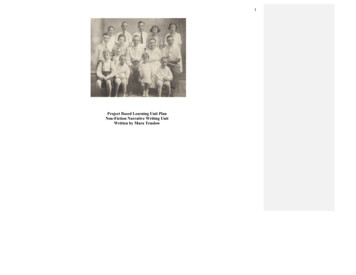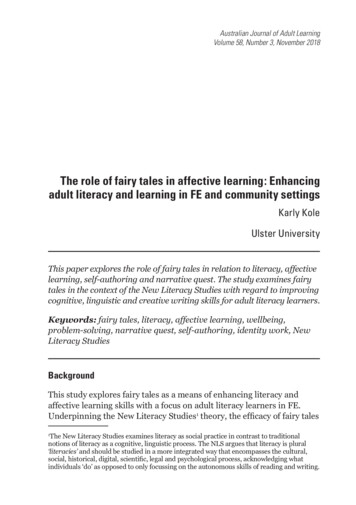
Transcription
Creating LiteracyInstruction for AllChildren in GradesPre‐K to 4M01 GUNN0823 08 SE C01.indd 118/05/12 11:03 AM
1M01 GUNN0823 08 SE C01.indd 2The Nature ofLiteracy and Today’sChildren18/05/12 11:03 AM
Anticipation GuideComplete the anticipation guide below. It will help to activate your prior knowledge so that you interact more fully with the chapter. It is designed toprobe your attitudes and beliefs about important and sometimes controversialtopics. There are often no right or wrong answers; the statements will alert you toyour attitudes about reading instruction and encourage you to become aware of areas where you might require additional information. At the end of the chapter,you might respond to the anticipation guide again to see if your answers havechanged in light of what you have read. For each of the following s tatements,put a check under “Agree” or “Disagree” to show how you feel. Discuss yourresponses with classmates before you read the chapter.AgreeDisagree1. Before children learn to read, they should know the sounds of most letters.2. Reading should not be fragmented into a series of subskills.3. Oral reading should be accurate.4. Phonics should be taught only when a need arises.5. Reading short passages and answering questions about them provideexcellent practice.6. Mistakes in oral reading should be ignored unless they change the senseof the passage.Using What You KnowThis chapter provides a general introduction to literacy instruction inpreschool and grades K–4. Before reading the chapter, examine your personalknowledge of the topic so that you willbe better prepared to interact with theinformation. Sometimes, you may notrealize what you know until you stop andthink about it. Think over what you knowabout the nature of reading. What do you think reading is? What do you do whenyou read? What do you think the reader’s role is? Is it simply to receive the author’s3M01 GUNN0823 08 SE C01.indd 318/05/12 11:03 AM
4 Chapter 1The Nature of Literacy and Today’s ChildrenFYIUsing What You Know is designedto activate your prior knowledgeon the general topic of the chapter.Sometimes, we don’t realize thatwe already know something abouta topic until we stop and thinkabout it. By activating your prior knowledge, you will be better prepared to make connectionsbetween new information containedin this chapter and what youalready know. When working withstudents, be sure to activate theirprior knowledge before they reada selection. Building LanguageBecause of the importance of language, suggestions for fosteringlanguage development have beenincluded in the marginal notesentitled Building Language. FYIOne of the best things parentscan do for their children is toread to them. They can also takethem to the library; buy booksfor them; and, most importantof all, show an interest in theirliteracy development. One ofthe main benefits of readingbooks to children is that it offersan opportunity for the parentand child to have a conversation. message, or should it include some personal input? How about writing? Whatprocesses do you use when you write?How would you go about teaching reading and writing to today’s students?What do you think the basic principles of a literacy program should be? Whatelements have worked especially well in programs with which you are familiar?The Nature of Reading“Awake! Awake!” These are the first words I remember reading. But thewords were as magical as any I have read since. Even after all these years,I still have vivid memories of that day long ago in first grade when readingcame alive for me and, indeed, awakened a lifetime of reading and a careeras a reading teacher.Reading is, first and foremost, magical, as those who recall learningto read or have witnessed their students discover the process will attest.It opens the door to a vast world of information, fulfillment, and enjoyment. After having learned to read, the person is never quite the same.Although magical, reading is complex. Becoming an effective teacher ofreading requires a grounding in the theories behind reading acquisition andinstruction. As Pinnell, a noted literacy researcher and practitioner, states:Understanding learning is the only true foundation for sound teaching. Nomatter how good the materials, the program, or the instructional approach,teaching will miss the mark if it is not based on a coherent theory of learning.The word theory simply refers to the set of understandings that a teacherholds and believes about how children learn. Everything teachers do in theclassroom proceeds from this set of beliefs and understandings, whether theyare conscious of it or not. (Pinnell, 2006, p. 78) Major Theories of Literacy Learningand Language DevelopmentThe first step, then, in understanding reading requires understandinghow children learn and how language develops. There are a number oftheories that describe how children learn. They fall into two broad areas: behaviorism and cognitivism.BehaviorismBehaviorism stresses observable responses to stimuli. In a behavioral approach, learning consists of the acquisition of new behaviors. R esponsesthat are reinforced increase in Reading is a process in which we construct Behaviorism is a philosophy of learning thatfrequency. Responses that aremeaning from print.describes all the activities of an organism innot reinforced are extinguishedterms of observable actions or behaviors.(do not occur again). A responseM01 GUNN0823 08 SE C01.indd 418/05/12 11:03 AM
Major Theories of Literacy Learning and Language Developmentthat has been conditioned to a particular stimulus should be elicited if thatstimulus is presented. Behaviors are learned or increased when a personreceives reinforcers such as praise, privileges, gold stars, or monetary rewards or simply sees that the responses are correct. A basic principle ofbehaviorism is that we tend to repeat behaviors that are rewarding andavoid those that are not. According to behaviorism, we are passive receiversof knowledge rather than active constructors. B ehavioral approaches tendto be teacher-centered.Scripted programs, such as Reading Mastery, often take a behavioralapproach. In Reading Mastery students first learn individual letter soundsand then learn to blend the sounds to form words. The teacher points toa letter and says, “Here is a new sound.” The teacher touches the letterand says the sound for the letter. Students are told to say the sound whenthe teacher touches the letter. Signals are used so that students respond inunison. Then individuals are called upon to say the sound. One objectiveof this procedure is to obtain as many correct responses from each childas possible. Incorrect responses are quickly corrected so that they will beextinguished.5Using TechnologyThe Association for Direct Instruction provides informationabout Reading Mastery, which is abottom-up approach. Its Web site(http://www.adihome.org) has filmclips showing Reading Mastery lessons. Click on Support Services andthen on Movie Clips. CognitivismBehavioral approaches to learning, with their emphasis on external forces,dominated from about the 1890s until about the 1950s. Rejecting a strictlyexternal view of learning, cognitive psychologists became interested inthe inner workings of the mind. Cognitivism is based on the propositionthat mental processes exist and can be studied. A related proposition is that humans are active participants in their learning rather than passive recipients. Reinforcement is seen as being important in learning, not just becauseit strengthens responses, but because it is a source of information or feedback (Woolfolk, 2001). Cognitive approaches tend to be student-centered.Piaget’s theories are examples of a cognitive approach to learning. Piagetis also known as a constructivist because of his emphasis on the ways inwhich children construct an understanding of the world.Piaget’s Theories Jean Piaget, a Swiss psychologist, stressed stagesof cognitive development and the unique nature of children’s thinking.As an adherent of constructivism, he believed that children construct theirown understanding of reality and do not simply reproduce what they seeand hear. Children’s thinking, according to Piaget, is qualitatively differentScripted program is one in whichthe teacher is provided with specific teaching directions, including the wordingof directions and instruction. M01 GUNN0823 08 SE C01.indd 5Cognitivism is a philosophy of learningthat describes the activities of an organismin terms of observable actions or behaviorsand internal or mental states. Constructionism (constructivism) is ac ognitive philosophy of learning that describeslearning as an active process in which thelearner constructs mental models of reality. 18/05/12 11:03 AM
6 Chapter 1The Nature of Literacy and Today’s Childrenfrom adults’ thinking, and it evolves through a series of hierarchical stages.He also believed that children’s thinking develops through direct experiencewith their environment. Through adaptation, or interaction with theenvironment, the child constructs psychological structures, or schemes,which are ways of making sense of the world. Adaptation includes twocomplementary processes: assimilation and accommodation. Throughassimilation, the child interprets the world in terms of his or her schemes.Seeing a very small dog, the child calls it “doggie” and assimilates this inhis or her dog scheme. Seeing a goat for the first time, the child might relateit to his or her dog scheme and call it “doggie.” Later, realizing that there issomething different about this creature, the child may accommodate thedog scheme and exclude the goat and all creatures with horns. Thus, thechild has refined the dog scheme. To Piaget, direct experience rather thanlanguage was the key determiner of cognitive development.Social Cognitive Views of LearningAccording to social cognitive theories, people are an important elementin the learning equation. We learn from and with others. L. S. Vygotsky(1962), an adherent of social constructivism, stressed the importanceof social factors in cognitive development. Although both Piaget and Vygotsky believed that children need to interact with the world aroundthem, Vygotsky thought that learning results from both direct experience and social interaction. Vygotsky is best known for the concept ofthe zone of proximal development (ZPD). He distinguished betweenactual and potential development. Actual development is a measure of the level at which a child is functioning. In a sense, it is a measure ofwhat the child has learned up to that point. Potential development is ameasure of what the child might be capable of achieving. The differencebetween the two levels is the zone of proximal development. As explainedby Vygotsky (1978), the zone of proximal development is “the distancebetween the actual developmental level as determined by independentproblem solving and the level of potential development as determinedthrough problem solving under adult guidance or in collaboration withmore capable peers” (p. 84). In other words, the zone of proximal development is the difference between what a child can do on his or her ownand what the child can do with help.Focusing on the importance of interaction with adults or knowledgeablepeers, Vygotsky’s theory is that children learn through expert guidance. Intime, they internalize the concepts and strategies employed Assimilation is the process of incorporating Zone of proximal development (ZPD) isby their mentors and so, ultinew ideas into existing ones.the area between independent performance Accommodation is the process by whichand potential as determined through problemmately, are able to perform onconcepts or schema are modified or new onessolving under guidance of an adult or morea higher level. The supportcreated to accommodate new knowledge.capable peer.and guidance provided by anM01 GUNN0823 08 SE C01.indd 618/05/12 11:03 AM
Major Theories of Literacy Learning and Language Developmentadult or more capable peer is known as scaffolding (Bruner, 1975, 1986).When parents converse with a child acquiring language, they respond ata higher level of language use but one that is in the child’s zone of proximal development. In their responses, they provide contextual support byrestating, repeating key words, and/or focusing on meaning rather thanform. Support at the beginning levels of language learning is extensive butis gradually decreased as the child progresses.Ideally, instruction should be pitched somewhat above a child’s c urrentlevel of independent functioning. Instruction and collaboration with anadult or with more capable peers will enable a child to reach a higher leveland ultimately function on that level. Instruction and interaction are keyelements. The overall theories of evaluation and instruction presentedin this book are grounded in Vygotsky’s concepts of actual and potential development and the zone of proximal development.Implications based on an integration of the theories of Piaget and Vygotsky are listed below: Provide students with hands-on experiences and opportunities to makediscoveries. Be aware and plan for individual differences. Because children have different experiences and come from different backgrounds, they developat different rates. Children learn best when activities are developmentally appropriate.Careful observation of processes the child is using provides insight intothe child’s level of development. Classrooms should be rich in verbal guidance. Interaction with theteacher and peers fosters learning. Modeling of strategies for improvingcomprehension and using context clues are examples of ways teachersfoster social cognitive learning.7FYIVygotsky differentiated betweenlearning and development. According to him, learning canoften cause qualitative changesin the nature of thought. Certainkinds of knowledge can lead tohigher levels of thinking (Bodrova& Leong, 2007). Behaviorists assertthat the child simply acquires moreknowledge. FYIVygotsky neglected the importanceof other ways of learning. Childrencan and do learn through n onverbalimitation and self-discovery(Berk, 1997). R e f l e c t i o nHow might you apply Vygotskyanprinciples in your classroom?Cognitive Behavioral ApproachBehavioral and cognitive principles have been combined in an approachknown as cognitive behavioral modification. Our behavior is affected bythe set of rewards and punishments we have experienced in the past and byour beliefs, thoughts, and expectations (Westmont Psychology D epartment,2008). Suppose that, based on your past experience of receiving low gradeson tests, you believe that you are not very smart and therefore it won’tmake much difference if you study for a test. So you don’t study, and youget a poor grade, thus reinforcing your lack of self-efficacy. A cognitive behavioral approach helps students change their attributions so they seethat effort is required for success. They also learn to see themselves ascompetent learners. Cognitive Scaffolding refers to the support and guidance provided by an adult that helps a studentbehavioral classroom managefunction on a higher level.ment provides techniques forM01 GUNN0823 08 SE C01.indd 718/05/12 11:03 AM
8 Chapter 1The Nature of Literacy and Today’s Childrenstudents to gain control of their learning. Students are taught to set goals,establish and follow a plan for reaching each goal, m onitor their progress toward reaching that goal, and evaluate whether they have reachedit. Along with learning strategies for i mproving reading and writing, students are taught self-regulation strategies. A s tudent might set as a goalimproving comprehension of text content. The student might then use achecklist or self-talk to prompt her- or himself to set a purpose for reading, survey the text, think about what she or he knows about the topic,make predictions, ask questions while reading, and summarize at the endof each section. The student monitors the use of the strategies to see ifthey are helping and evaluates whether she or he is reaching the goal ofimproved c omprehension of the text. As Meichenbaum and Biemiller(1998) explain, practice usually involves “both physically performing theskill or skills involved in the task and v erbally guiding oneself (thinkingout loud— demonstrating self-regulation overtly) while carrying out thetask” (p. 126).FYIIn Goodman’s model, students usethree cueing systems: semantic,syntactic, and graphophonic.Semantic cues derive from pastexperiences, so students constructmeaning by bringing their background of knowledge to astory. Syntactic cues derive fromknowledge of how the structureof language works. Graphophoniccues refer to the ability to soundout words or recognize them holistically. Based on their use ofthese cues, students predict thecontent of the text, confirm orrevise their predictions, and rereadif necessary. Top-Down, Bottom-Up TheoriesAnother way of looking at theories of literacy learning is whether they aremainly bottom-up, top-down, or somewhere in between. On one end ofthe continuum are those who espouse a subskills, or bottom-up, approach,and on the other end are those who advocate a holistic, or top-down, approach. In between are the interactionists.Bottom-Uppers In the bottom-up approach, children literally start atthe bottom and work their way up. First, they learn the names and shapesof the letters of the alphabet. Next, they learn consonant sounds, followedby simple and then more complex vowel correspondences. Bottom-upprocedures are intended to make learning to read easier by breaking complextasks into their component skills. Instruction proceeds from the simple tothe complex. In essence, there are probably no 100 percent bottom-uppersamong reading teachers. Even those who strongly favor phonics recognizethe importance of higher-level strategies.Top-Downers A top-down approach starts at the top and worksdownward. Learning to read is seen as being similar to learning to speak;it is holistic and progresses naturally through immersion. Subskills are notHolistic refers to the practice of learning through the completion of whole tasksrather than fragmented subskills and fragments of reading and writing. M01 GUNN0823 08 SE C01.indd 8Bottom-up approach refers to a kind of processing in which meaning is derived from theaccurate, sequential processing of words. Theemphasis is on the text rather than the reader’s b ackground knowledge or language ability. Top-down processing refers to derivingmeaning by using one’s background knowledge, language ability, and expectations.The emphasis is on the reader rather thanthe text. 18/05/12 11:03 AM
Major Theories of Literacy Learning and Language Developmenttaught because it is felt that they fragment the process and make learningto read more abstract and difficult (Goodman, 1986). One of the mostinfluential models of reading is that proposed by Ken Goodman (1994b).According to Goodman, readers use their background knowledge andknowledge of language to predict and infer the content of print. Readers“use their selection strategies to choose only the most useful informationfrom all that is available” (Goodman, 1994b, p. 1125). When reading thesentence “The moon is full tonight,” the reader can use his or her knowledgeof the moon, context clues, and perhaps the initial consonants f and tto reconstruct full and tonight. According to Goodman’s theory, it is notnecessary for the reader to process all the letters of full and tonight. However,to make use of background knowledge, context clues, and initial consonantcues, the reader must consider the whole text. If the words full and tonightwere read in isolation, the reader would have to depend more heavily onprocessing all or most of the letters of each word. As far as comprehensionis concerned, the top-down view is that students build their understandingthrough discussions of high-quality literature or informational texts. Thereis generally no direct, explicit instruction of comprehension strategies.9FYIMany theorists claim that, whenreading, we process virtually everyword and virtually every letter inthe words, but that context fostersboth speed and accuracy of wordrecognition (Adams, 1990). Interactionists Most practitioners tend to be more pragmatic than eitherstrict top-downers or dyed-in-the-wool bottom-uppers and borrow practicesfrom both ends of the continuum. These interactionists teach skills directlyand systematically—especially in the beginning—but they avoid overdoing itbecause they do not want to fragment the process. They also provide plentyof opportunities for students to experience the holistic nature of readingand writing by having them read whole books and write for real purposes.Pressley (2006) found that most were interactionists. As cognitive psychologistM. H. Ashcroft (1994) notes, “Any significant mental task will involve both datadriven (bottom-up) and conceptually driven (top-down) processing” (p. 75).In an interactive, compensatory model, students use top-down processes to compensate for weakness in bottom-up processes, or vice versa.For instance, students who have weak decoding skills make heavy use ofcontext to make sense of a passage. On the other hand, when contentis unfamiliar, readers get all they can out of the data. They read everyword carefully, may reread it several times, and may even read it out loud.Think about how you read a set of directions for completing a complex,unfamiliar activity or a list of new tax regulations.Where do you fit on the continuum? Go back to the anticipation guide atthe beginning of the chapter. Review how you answered the six statements.If you agreed with only the odd-numbered ones, you are a bottom-up advocate. If you agreed with only the even-numbered ones, you are probably a top-downer. If your answers are mixed, you are probably an interactionist. Still another way of looking at reading is from a literary theory view.Literary theory explores the role of the reader.M01 GUNN0823 08 SE C01.indd 9R e f l e c t i o nWhat is your position on the bottom-up, top-down continuum?How might your approach affectyour instruction?18/05/12 11:03 AM
10 Chapter 1The Nature of Literacy and Today’s ChildrenThe Reader’s Role in the Reading ProcessWhat is the reader’s role in the reading process? In the past, it was defined asbeing passive, getting the author’s meaning. Today, reading requires a more active role—the reader must construct meaning from text. The m odel of transmission of information in which the reader was merely a recipient has givenway to transactional theory, a two-way process involving a reader and a text:FYITo clarify one’s philosophy of teaching, ask: “What are myinstructional practices and why amI doing what I’m doing?” E xaminingyour practices, should help youuncover your beliefs. Every reading act is an event, or a transaction, involving a particularr eader and a particular pattern of signs, a text, and occurring at a particular time in a particular context. Instead of two fixed entities acting on oneanother, the reader and the text are two aspects of a total dynamic situation.The “meaning” does not reside ready-made “in” the text or “in” the readerbut happens or comes into being during the transaction between reader andtext. (Rosenblatt, 1994, p. 1063)In her study of how students read a poem, Rosenblatt (1978) noted thateach reader was active:Using TechnologyControversies such as “Is r eadingtop down or bottom up?” areoften explored on the Websites of professional organizations, such as the International Reading Association’s Web site:http://reading.org FYIThis book takes the position that allsources of information—semantic,syntactic, background knowledge,and letter–sound relationships—areessential when processing text andemphasizes the use of both contextand phonics. However, the text alsoagrees that even in mature reading,nearly all words are processed. He was not a blank tape registering a ready-made message. He was activelyinvolved in building up a poem for himself out of his responses to text. He hadto draw on his past experiences with the verbal symbols. . . . The reader was notonly paying attention to what the words pointed to in the external world, totheir referents; he was also paying attention to the images, feelings, attitudes,associations, and ideas that the words and their referents evoked in him. (p. 10)Does it make any difference whether reading is viewed as beingt ransmissional, transactional, or somewhere in between? Absolutely. If reading is viewed as transmissional, students are expected to stick close to theauthor’s message. If reading is viewed as transactional, students are expectedto put their personal selves into their reading, especially when encounteringliterature. From a transactional perspective, building background becomesespecially important because it enriches the transaction between reader andtext. Personal response and interpretation are at the center of the readingprocess. The reader’s role is enhanced when a transactional view prevails.See Table 1.1 for a summary of theories of learning.Approach Taken by this TextThis book draws heavily on research in cognitive psychology, combinesan interactionist point of view with a holistic orientation, and takes an integrated approach. Both the bottom-up and top-down approaches are stepby step (Kamhi & Catts, 1999).In the bottom-up model, the Transaction refers to the relationship between the reader and the text in which the text is reader progresses from letter toconditioned by the reader and the reader is conditioned by the text.sound to word. In the top-downM01 GUNN0823 08 SE C01.indd 1018/05/12 11:03 AM
The Reader’s Role in the Reading ProcessTable 1.111Theories of Learning and Reading Observable behavior is stressed. Responses to stimuli are reinforced or extinguished. Drills;guided practice; and acquisition of facts, skills,and c oncepts are emphasized.Mental processes are important. Students are activelearners as they use strategies to acquire facts, skill,and concepts.Through active experiences, children construct theirunderstanding of the world.Present and reinforce skills, such as phonics,in systematic fashion.Reinforce appropriate behavior.CognitivismConstructivismSocial constructivismCognitive behavioralInteractionistReader responseThoughts and ideas of others are an essential element in constructing knowledge. Students learnthrough expert guidance from more knowledgeable others. Social interaction, the zone of proximaldevelopment, and scaffolding are key elements inlearning.Learning is affected by the learning task and situation and the ability, interests, and attitudes ofthe students. Students use self-regulation to acquirefacts, skills, and concepts.Both top-down and bottom-up processes are used.Students are active learners as they employ strategiesto acquire facts, skills, and concepts.Reading is a transaction in which the reader affectsthe text and is affected by it.Teach strategies.Ask questions that help reveal students’ thinking.Arrange for learning experiences and opportunitiesfor problem solving.Gear instruction to students’ stage of development.Focus on inquiry and discovery learning.Make sure students are in their zone of proximaldevelopment.Co-construct knowledge with students.Scaffold students’ learning.Build self-efficacy. Teach students to set goals andself-regulate. Walk students through the process ofsetting goals, working to reach goals, and monitoring progress.Teach students to use phonics skills and context.Encourage students to relate new learning to whatthey already know.Use compensatory mechanisms.Emphasize personal responses and interpretations.Encourage students to make personal connectionsto what they have read.Source: Portions of the chart are adapted from Woolfolk (2001), Table 9.8, Four Views of Learning (p. 358). process, the reader p roceeds from sampling of language cues to predictionand to confirmation. In an integrated approach, however, the processesoccur in parallel fashion. For instance, when students decode words, four processors are at work: orthographic, phonological, meaning, and context (Adams, 1990, 1994). The orthographic processor is responsible for perceiving the sequences of letters in text. The phonological processor isresponsible for mapping the letters into their spoken equivalents. The meaning processor contains one’s knowledge of word meanings, and the context processor is in charge of constructing a continuing understanding of thetext (Stahl, Osborne, & Lehr, 1990). The processors work simultaneously,and both receive information and send it to the other processors; however,the orthographic and phonological processors are always essential participants. Context may speed and/or assist the interpretation of orthographicand phonological information but does not take its place (see Figure 1.1).When information from one processor is weak, another may be called onM01 GUNN0823 08 SE C01.indd 1118/05/12 11:03 AM
12 Chapter 1Figure 1.1The Nature of Literacy and Today’s ChildrenModeling the Reading Systems: Four e: Adams, M. J. (1990). Beginning to read: Thinking and learning about print: A summary. Prepared by S. A. Stahl, J. Osborne, & F. Lehr.Urbana-Champaign, IL: Center for the Study of Reading, University of Illinois.Using TechnologyTo find the results of the latestNational Assessment in readingand other areas, consult the Website for the National Center for Educational Statistics: http://nces.ed.gov/indihomeasp M01 GUNN0823 08 SE C01.indd 12to give assistance. For instance, when a word such as lead is encountered,the context processor provides extra
of the level at which a child is functioning. In a sense, it is a measure of what the child has learned up to that point. Potential development is a measure of what the child might be capable

